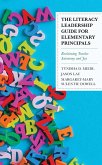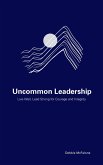Gary Whiteley, Lexie Domaradzki, Arthur L. Costa, Patricia Muller
Dispositions of Leadership (eBook, ePUB)
The Effects on Student Learning and School Culture
33,95 €
33,95 €
inkl. MwSt.
Sofort per Download lieferbar

17 °P sammeln
33,95 €
Als Download kaufen

33,95 €
inkl. MwSt.
Sofort per Download lieferbar

17 °P sammeln
Jetzt verschenken
Alle Infos zum eBook verschenken
33,95 €
inkl. MwSt.
Sofort per Download lieferbar
Alle Infos zum eBook verschenken

17 °P sammeln
Gary Whiteley, Lexie Domaradzki, Arthur L. Costa, Patricia Muller
Dispositions of Leadership (eBook, ePUB)
The Effects on Student Learning and School Culture
- Format: ePub
- Merkliste
- Auf die Merkliste
- Bewerten Bewerten
- Teilen
- Produkt teilen
- Produkterinnerung
- Produkterinnerung

Bitte loggen Sie sich zunächst in Ihr Kundenkonto ein oder registrieren Sie sich bei
bücher.de, um das eBook-Abo tolino select nutzen zu können.
Hier können Sie sich einloggen
Hier können Sie sich einloggen
Sie sind bereits eingeloggt. Klicken Sie auf 2. tolino select Abo, um fortzufahren.

Bitte loggen Sie sich zunächst in Ihr Kundenkonto ein oder registrieren Sie sich bei bücher.de, um das eBook-Abo tolino select nutzen zu können.
Dispositions of Leadership: The Effects on Student Learning and School Culture stands alone as an approach for developing leaders who are adaptive and can thrive in unpredictable settings. Educational leadership is a domain of its own, apart from business and industry, combining an effective learning environment for students and adults. Dispositions are acquired in the interactions between skillful thinking and circumstances that defy simplistic solutions. The five dispositions, as illustrated in the book, provide educational leaders with maps of the territory and examples of habits for…mehr
- Geräte: eReader
- mit Kopierschutz
- eBook Hilfe
- Größe: 2.57MB
Andere Kunden interessierten sich auch für
![Structuring Learning Environments in Teacher Education to Elicit Dispositions as Habits of Mind (eBook, ePUB) Structuring Learning Environments in Teacher Education to Elicit Dispositions as Habits of Mind (eBook, ePUB)]() Erskine S. DottinStructuring Learning Environments in Teacher Education to Elicit Dispositions as Habits of Mind (eBook, ePUB)60,95 €
Erskine S. DottinStructuring Learning Environments in Teacher Education to Elicit Dispositions as Habits of Mind (eBook, ePUB)60,95 €![Dispositions Are a Teacher's Greatest Strength (eBook, ePUB) Dispositions Are a Teacher's Greatest Strength (eBook, ePUB)]() Michelle C. HughesDispositions Are a Teacher's Greatest Strength (eBook, ePUB)30,95 €
Michelle C. HughesDispositions Are a Teacher's Greatest Strength (eBook, ePUB)30,95 €![Professional Teacher Dispositions (eBook, ePUB) Professional Teacher Dispositions (eBook, ePUB)]() R. Lee SmithProfessional Teacher Dispositions (eBook, ePUB)28,95 €
R. Lee SmithProfessional Teacher Dispositions (eBook, ePUB)28,95 €![Social Justice Dispositions in Schools (eBook, ePUB) Social Justice Dispositions in Schools (eBook, ePUB)]() Russell CrossSocial Justice Dispositions in Schools (eBook, ePUB)43,95 €
Russell CrossSocial Justice Dispositions in Schools (eBook, ePUB)43,95 €![Critical Dispositions (eBook, ePUB) Critical Dispositions (eBook, ePUB)]() Greg DimitriadisCritical Dispositions (eBook, ePUB)49,95 €
Greg DimitriadisCritical Dispositions (eBook, ePUB)49,95 €![The Literacy Leadership Guide for Elementary Principals (eBook, ePUB) The Literacy Leadership Guide for Elementary Principals (eBook, ePUB)]() Tynisha D. MeidlThe Literacy Leadership Guide for Elementary Principals (eBook, ePUB)20,95 €
Tynisha D. MeidlThe Literacy Leadership Guide for Elementary Principals (eBook, ePUB)20,95 €![Uncommon Leadership (eBook, ePUB) Uncommon Leadership (eBook, ePUB)]() Debbie McFaloneUncommon Leadership (eBook, ePUB)18,95 €
Debbie McFaloneUncommon Leadership (eBook, ePUB)18,95 €-
-
-
Dispositions of Leadership: The Effects on Student Learning and School Culture stands alone as an approach for developing leaders who are adaptive and can thrive in unpredictable settings. Educational leadership is a domain of its own, apart from business and industry, combining an effective learning environment for students and adults. Dispositions are acquired in the interactions between skillful thinking and circumstances that defy simplistic solutions. The five dispositions, as illustrated in the book, provide educational leaders with maps of the territory and examples of habits for intelligent responses to complex problems. Educational leaders must develop adaptive competence, the capability of applying prior leaning to a novel setting, while assessing the impact of potential solutions. This book challenges the utility of traditional command-and-control models that are no longer capable of supporting school leaders. Grounded in extensive research and review of leadership literature. Dispositions of Leadership: The Effects on Student Learning and School Culture describes how an effective educational leader in the Information Age applies dispositional thinking in order to be adaptive, self-aware and responsive to others.
Produktdetails
- Produktdetails
- Verlag: Bloomsbury eBooks US
- Seitenzahl: 208
- Erscheinungstermin: 10. August 2017
- Englisch
- ISBN-13: 9781475836271
- Artikelnr.: 48862217
- Verlag: Bloomsbury eBooks US
- Seitenzahl: 208
- Erscheinungstermin: 10. August 2017
- Englisch
- ISBN-13: 9781475836271
- Artikelnr.: 48862217
- Herstellerkennzeichnung Die Herstellerinformationen sind derzeit nicht verfügbar.
Gary Whiteley's passion for understanding the nature and implication of effective school leadership spans four decades. His leadership journey continues to be enhanced by thoughtful colleagues who co-authored this book.
Dedication
List of Figures
List of Tables
Foreword
Preface
Acknowledgements
Introduction
Complexity of the Contemporary Educational System
Why Are New Understandings of Educational Leadership Needed?
Learning Environments and the Need for Adaptive Competence
Habits of Mind or Dispositions
Educational Leadership in the Information Age
Overview of the Book
Questions to Engage your Thinking and Discussion with Colleagues
References
Chapter One: What Effect Does Educational Leadership Have on Student
Learning?
The Century-Long Evolution of Educational Leadership
Twenty-five Important Works in Five Tables
Efficiency, Bureaucracy, and the Heroic Leader - 1911-1967
Transformational Leadership and the Learning Organization - 1978-1990
Adaptive Leadership a Response for Addressing Complexity - 1993-2003
The Agile Organization and Adaptive Leadership - 2005-2009
A Home of Our Own Emerges: Leading Linked with Student Learning - 2011-
2013
Summary of the Five Tables and 25 Important Books for Leadership and
Learning
A New Era of Leadership with Student Learning as the Pervasive Focus
Leadership Dimensions and Core Leadership Practices: Broader-Grained Work
The Three Capabilities and Four Pathways: Finer-Grained Leadership Work
Summary
Questions to Engage Your Thinking and Discussion with Colleagues
References
Chapter Two: How Does an Agile Organization Support Contemporary School
Leadership?
The Formal Organization: An Overview
Formal Organization: Routine Analytical and Routine Cognitive Problem
Solving
Agile Organizations: Adapting the Formal Organization to Meet 21st Century
Needs
Agile Organizations: Non-Routine Analytical and Interactive Problem Solving
Asserting Focus Amidst Complexity: A Challenge in the Information Age
Agility: Identifying the Type of Problem or Challenge
Technical Problems, Adaptive Challenges, and Polarity Management
Network-centric Collaborative Groups, Agility, and Decision-making
High-Performing Principal Teams and School-based Leadership Teams
Summary
Questions to Engage your Thinking and Discussion with Colleagues
References
Chapter Three: What Are the Dispositions of Contemporary Educational
Leadership?
What are Dispositions?
Why Dispositions?
Dispositions for Educational Leadership
What Roles Do Dispositions Serve in Leadership?
How are Dispositions Acquired?
Why Consider Utilizing Thinking Dispositions with Educators?
Dispositions Build the School Culture
The Five Dispositions of Leadership
Dispositions, Capabilities, and Practices: Ways of Thinking, Being, Doing
The Balcony and the Dance Floor
Summary
Questions to Engage your Thinking and Discussion with Colleagues:
References
Chapter Four: Disposition: Thinking and Acting Interdependently
Capability One: Establishing and Maintaining an Environment of Trust that
Includes Predictable Values and Predictable Skills
Capability Two: Identifying, Articulating, and Aligning with a Shared
Vision that Addresses a Pervasive Focus on Student and Adult Learning
Capability Three: Promote a Group of Diverse Individuals to Access and
Utilize Resources and Expertise Across a Broader Community
Capability Four: Setting Aside Your Own Preferences for the Benefit of All
Capability Five: Having the Capacity to Look at Things from Others' Point
of View
Capability Six: Anticipating Ways to Support Others in the Collaborative
Process
Summary
Middle School Vignette
Questions to Engage your Thinking and Discussion with Colleagues
References
Chapter Five: Communicating to Influence
Capability One: Developing the Capabilities within Others to Interact
Successfully
Discussion
Dialogue
Capability Two: Developing Personal Presence
Capability Three: Knowing When and Why to Integrate and Knowing When to
Insert Oneself
Capability Four: Use Interpersonal Skills to Cultivate Working
Relationships and to Motivate and Mobilize Others (Individuals and Groups)
Summary
Middle-school Vignette
Questions to Engage your Thinking and Discussion with Colleagues
References
Chapter Six: Gathering and Applying Information for Change
Capability One: Systematically and Intentionally Gathering and Organizing
Needed Data
Academic Content and Measures of Schooling
Student Engagement in the Behavior, Emotional, And Cognitive Dimensions
Information Collected for Evaluating Implementation Topics
Capability Two: Using data to inform actions
Capability Three: Developing and Nurturing an Environment of Inquiry and
Innovation Grounded in Reflection and Continuous Improvement
Summary
Middle School Vignette
Questions to Engage Your Thinking and Discussion with Colleagues
References
Chapter Seven: Seeking Support for Feedback and Learning
Capability One: Developing Self-Knowledge, Self-Awareness and Self-Efficacy
While Maintaining a Sense of Humility
Capability Two: Frequently Seeking Feedback Focused on Learning and
Professional Growth
Capability Three: Engaging in a Collegial Networked Leadership Community of
High-Performing Teams of Principals
Problems of Practice Versus Practice-Based Evidence
Effective Networked Leadership Communities
Relationship Between Support, Resiliency, Feedback and Excellence
Professional Goal Setting
Capability Four: Creating Feedback Spirals for Continuous Individual and
Organizational Self-Learning
Receiving Feedback
Giving Feedback
Summary
Middle School Vignette
Questions to Engage Your Thinking and Discussion with Colleagues
Chapter Eight: Pursuing Adaptive Competence
What is Adaptive Competence?
Pursuing Adaptive Competence in Ambiguous Environments
Capability One: Using Self-Managing, Self-Monitoring, and Self-Modifying
Skills to Inform Behaviors and Actions
Capability Two: Engaging Flexibly in Thinking and Behaviors
Capability Three: Solving Complex Problems and Addressing Adaptive
Challenges
Summary
Middle School Vignette: Three Middle School Principals
Questions to Engage Your Thinking and Discussion with Colleagues:
References
Chapter Nine: Discovering Leadership Potential in an Agile Organization
Five Dispositions of Leadership:
Thinking and Acting Interdependently: Promoting a positive, collaborative
learning culture through distributed leadership.Communicating to Influence:
Developing the interpersonal skills to influence, mobilize and motivate
individuals and groups.Gathering and Appling Information for Change:
Utilizing data-based evidence to make decisions and provide formative
feedback for setting direction and planning change.Seeking Support and
Feedback for Learning: Fostering personal/professional growth and
resiliency. Pursuing Adaptive Competence (Keystone Disposition):
Incorporating into practice metacognition and cognitive flexibility to
effectively plan, reflect, diagnose, and solve complex problems. Feedback:
A Networked Leadership Community Vignette
Questions for Reflection
List of Figures
List of Tables
Foreword
Preface
Acknowledgements
Introduction
Complexity of the Contemporary Educational System
Why Are New Understandings of Educational Leadership Needed?
Learning Environments and the Need for Adaptive Competence
Habits of Mind or Dispositions
Educational Leadership in the Information Age
Overview of the Book
Questions to Engage your Thinking and Discussion with Colleagues
References
Chapter One: What Effect Does Educational Leadership Have on Student
Learning?
The Century-Long Evolution of Educational Leadership
Twenty-five Important Works in Five Tables
Efficiency, Bureaucracy, and the Heroic Leader - 1911-1967
Transformational Leadership and the Learning Organization - 1978-1990
Adaptive Leadership a Response for Addressing Complexity - 1993-2003
The Agile Organization and Adaptive Leadership - 2005-2009
A Home of Our Own Emerges: Leading Linked with Student Learning - 2011-
2013
Summary of the Five Tables and 25 Important Books for Leadership and
Learning
A New Era of Leadership with Student Learning as the Pervasive Focus
Leadership Dimensions and Core Leadership Practices: Broader-Grained Work
The Three Capabilities and Four Pathways: Finer-Grained Leadership Work
Summary
Questions to Engage Your Thinking and Discussion with Colleagues
References
Chapter Two: How Does an Agile Organization Support Contemporary School
Leadership?
The Formal Organization: An Overview
Formal Organization: Routine Analytical and Routine Cognitive Problem
Solving
Agile Organizations: Adapting the Formal Organization to Meet 21st Century
Needs
Agile Organizations: Non-Routine Analytical and Interactive Problem Solving
Asserting Focus Amidst Complexity: A Challenge in the Information Age
Agility: Identifying the Type of Problem or Challenge
Technical Problems, Adaptive Challenges, and Polarity Management
Network-centric Collaborative Groups, Agility, and Decision-making
High-Performing Principal Teams and School-based Leadership Teams
Summary
Questions to Engage your Thinking and Discussion with Colleagues
References
Chapter Three: What Are the Dispositions of Contemporary Educational
Leadership?
What are Dispositions?
Why Dispositions?
Dispositions for Educational Leadership
What Roles Do Dispositions Serve in Leadership?
How are Dispositions Acquired?
Why Consider Utilizing Thinking Dispositions with Educators?
Dispositions Build the School Culture
The Five Dispositions of Leadership
Dispositions, Capabilities, and Practices: Ways of Thinking, Being, Doing
The Balcony and the Dance Floor
Summary
Questions to Engage your Thinking and Discussion with Colleagues:
References
Chapter Four: Disposition: Thinking and Acting Interdependently
Capability One: Establishing and Maintaining an Environment of Trust that
Includes Predictable Values and Predictable Skills
Capability Two: Identifying, Articulating, and Aligning with a Shared
Vision that Addresses a Pervasive Focus on Student and Adult Learning
Capability Three: Promote a Group of Diverse Individuals to Access and
Utilize Resources and Expertise Across a Broader Community
Capability Four: Setting Aside Your Own Preferences for the Benefit of All
Capability Five: Having the Capacity to Look at Things from Others' Point
of View
Capability Six: Anticipating Ways to Support Others in the Collaborative
Process
Summary
Middle School Vignette
Questions to Engage your Thinking and Discussion with Colleagues
References
Chapter Five: Communicating to Influence
Capability One: Developing the Capabilities within Others to Interact
Successfully
Discussion
Dialogue
Capability Two: Developing Personal Presence
Capability Three: Knowing When and Why to Integrate and Knowing When to
Insert Oneself
Capability Four: Use Interpersonal Skills to Cultivate Working
Relationships and to Motivate and Mobilize Others (Individuals and Groups)
Summary
Middle-school Vignette
Questions to Engage your Thinking and Discussion with Colleagues
References
Chapter Six: Gathering and Applying Information for Change
Capability One: Systematically and Intentionally Gathering and Organizing
Needed Data
Academic Content and Measures of Schooling
Student Engagement in the Behavior, Emotional, And Cognitive Dimensions
Information Collected for Evaluating Implementation Topics
Capability Two: Using data to inform actions
Capability Three: Developing and Nurturing an Environment of Inquiry and
Innovation Grounded in Reflection and Continuous Improvement
Summary
Middle School Vignette
Questions to Engage Your Thinking and Discussion with Colleagues
References
Chapter Seven: Seeking Support for Feedback and Learning
Capability One: Developing Self-Knowledge, Self-Awareness and Self-Efficacy
While Maintaining a Sense of Humility
Capability Two: Frequently Seeking Feedback Focused on Learning and
Professional Growth
Capability Three: Engaging in a Collegial Networked Leadership Community of
High-Performing Teams of Principals
Problems of Practice Versus Practice-Based Evidence
Effective Networked Leadership Communities
Relationship Between Support, Resiliency, Feedback and Excellence
Professional Goal Setting
Capability Four: Creating Feedback Spirals for Continuous Individual and
Organizational Self-Learning
Receiving Feedback
Giving Feedback
Summary
Middle School Vignette
Questions to Engage Your Thinking and Discussion with Colleagues
Chapter Eight: Pursuing Adaptive Competence
What is Adaptive Competence?
Pursuing Adaptive Competence in Ambiguous Environments
Capability One: Using Self-Managing, Self-Monitoring, and Self-Modifying
Skills to Inform Behaviors and Actions
Capability Two: Engaging Flexibly in Thinking and Behaviors
Capability Three: Solving Complex Problems and Addressing Adaptive
Challenges
Summary
Middle School Vignette: Three Middle School Principals
Questions to Engage Your Thinking and Discussion with Colleagues:
References
Chapter Nine: Discovering Leadership Potential in an Agile Organization
Five Dispositions of Leadership:
Thinking and Acting Interdependently: Promoting a positive, collaborative
learning culture through distributed leadership.Communicating to Influence:
Developing the interpersonal skills to influence, mobilize and motivate
individuals and groups.Gathering and Appling Information for Change:
Utilizing data-based evidence to make decisions and provide formative
feedback for setting direction and planning change.Seeking Support and
Feedback for Learning: Fostering personal/professional growth and
resiliency. Pursuing Adaptive Competence (Keystone Disposition):
Incorporating into practice metacognition and cognitive flexibility to
effectively plan, reflect, diagnose, and solve complex problems. Feedback:
A Networked Leadership Community Vignette
Questions for Reflection
Dedication
List of Figures
List of Tables
Foreword
Preface
Acknowledgements
Introduction
Complexity of the Contemporary Educational System
Why Are New Understandings of Educational Leadership Needed?
Learning Environments and the Need for Adaptive Competence
Habits of Mind or Dispositions
Educational Leadership in the Information Age
Overview of the Book
Questions to Engage your Thinking and Discussion with Colleagues
References
Chapter One: What Effect Does Educational Leadership Have on Student
Learning?
The Century-Long Evolution of Educational Leadership
Twenty-five Important Works in Five Tables
Efficiency, Bureaucracy, and the Heroic Leader - 1911-1967
Transformational Leadership and the Learning Organization - 1978-1990
Adaptive Leadership a Response for Addressing Complexity - 1993-2003
The Agile Organization and Adaptive Leadership - 2005-2009
A Home of Our Own Emerges: Leading Linked with Student Learning - 2011-
2013
Summary of the Five Tables and 25 Important Books for Leadership and
Learning
A New Era of Leadership with Student Learning as the Pervasive Focus
Leadership Dimensions and Core Leadership Practices: Broader-Grained Work
The Three Capabilities and Four Pathways: Finer-Grained Leadership Work
Summary
Questions to Engage Your Thinking and Discussion with Colleagues
References
Chapter Two: How Does an Agile Organization Support Contemporary School
Leadership?
The Formal Organization: An Overview
Formal Organization: Routine Analytical and Routine Cognitive Problem
Solving
Agile Organizations: Adapting the Formal Organization to Meet 21st Century
Needs
Agile Organizations: Non-Routine Analytical and Interactive Problem Solving
Asserting Focus Amidst Complexity: A Challenge in the Information Age
Agility: Identifying the Type of Problem or Challenge
Technical Problems, Adaptive Challenges, and Polarity Management
Network-centric Collaborative Groups, Agility, and Decision-making
High-Performing Principal Teams and School-based Leadership Teams
Summary
Questions to Engage your Thinking and Discussion with Colleagues
References
Chapter Three: What Are the Dispositions of Contemporary Educational
Leadership?
What are Dispositions?
Why Dispositions?
Dispositions for Educational Leadership
What Roles Do Dispositions Serve in Leadership?
How are Dispositions Acquired?
Why Consider Utilizing Thinking Dispositions with Educators?
Dispositions Build the School Culture
The Five Dispositions of Leadership
Dispositions, Capabilities, and Practices: Ways of Thinking, Being, Doing
The Balcony and the Dance Floor
Summary
Questions to Engage your Thinking and Discussion with Colleagues:
References
Chapter Four: Disposition: Thinking and Acting Interdependently
Capability One: Establishing and Maintaining an Environment of Trust that
Includes Predictable Values and Predictable Skills
Capability Two: Identifying, Articulating, and Aligning with a Shared
Vision that Addresses a Pervasive Focus on Student and Adult Learning
Capability Three: Promote a Group of Diverse Individuals to Access and
Utilize Resources and Expertise Across a Broader Community
Capability Four: Setting Aside Your Own Preferences for the Benefit of All
Capability Five: Having the Capacity to Look at Things from Others' Point
of View
Capability Six: Anticipating Ways to Support Others in the Collaborative
Process
Summary
Middle School Vignette
Questions to Engage your Thinking and Discussion with Colleagues
References
Chapter Five: Communicating to Influence
Capability One: Developing the Capabilities within Others to Interact
Successfully
Discussion
Dialogue
Capability Two: Developing Personal Presence
Capability Three: Knowing When and Why to Integrate and Knowing When to
Insert Oneself
Capability Four: Use Interpersonal Skills to Cultivate Working
Relationships and to Motivate and Mobilize Others (Individuals and Groups)
Summary
Middle-school Vignette
Questions to Engage your Thinking and Discussion with Colleagues
References
Chapter Six: Gathering and Applying Information for Change
Capability One: Systematically and Intentionally Gathering and Organizing
Needed Data
Academic Content and Measures of Schooling
Student Engagement in the Behavior, Emotional, And Cognitive Dimensions
Information Collected for Evaluating Implementation Topics
Capability Two: Using data to inform actions
Capability Three: Developing and Nurturing an Environment of Inquiry and
Innovation Grounded in Reflection and Continuous Improvement
Summary
Middle School Vignette
Questions to Engage Your Thinking and Discussion with Colleagues
References
Chapter Seven: Seeking Support for Feedback and Learning
Capability One: Developing Self-Knowledge, Self-Awareness and Self-Efficacy
While Maintaining a Sense of Humility
Capability Two: Frequently Seeking Feedback Focused on Learning and
Professional Growth
Capability Three: Engaging in a Collegial Networked Leadership Community of
High-Performing Teams of Principals
Problems of Practice Versus Practice-Based Evidence
Effective Networked Leadership Communities
Relationship Between Support, Resiliency, Feedback and Excellence
Professional Goal Setting
Capability Four: Creating Feedback Spirals for Continuous Individual and
Organizational Self-Learning
Receiving Feedback
Giving Feedback
Summary
Middle School Vignette
Questions to Engage Your Thinking and Discussion with Colleagues
Chapter Eight: Pursuing Adaptive Competence
What is Adaptive Competence?
Pursuing Adaptive Competence in Ambiguous Environments
Capability One: Using Self-Managing, Self-Monitoring, and Self-Modifying
Skills to Inform Behaviors and Actions
Capability Two: Engaging Flexibly in Thinking and Behaviors
Capability Three: Solving Complex Problems and Addressing Adaptive
Challenges
Summary
Middle School Vignette: Three Middle School Principals
Questions to Engage Your Thinking and Discussion with Colleagues:
References
Chapter Nine: Discovering Leadership Potential in an Agile Organization
Five Dispositions of Leadership:
Thinking and Acting Interdependently: Promoting a positive, collaborative
learning culture through distributed leadership.Communicating to Influence:
Developing the interpersonal skills to influence, mobilize and motivate
individuals and groups.Gathering and Appling Information for Change:
Utilizing data-based evidence to make decisions and provide formative
feedback for setting direction and planning change.Seeking Support and
Feedback for Learning: Fostering personal/professional growth and
resiliency. Pursuing Adaptive Competence (Keystone Disposition):
Incorporating into practice metacognition and cognitive flexibility to
effectively plan, reflect, diagnose, and solve complex problems. Feedback:
A Networked Leadership Community Vignette
Questions for Reflection
List of Figures
List of Tables
Foreword
Preface
Acknowledgements
Introduction
Complexity of the Contemporary Educational System
Why Are New Understandings of Educational Leadership Needed?
Learning Environments and the Need for Adaptive Competence
Habits of Mind or Dispositions
Educational Leadership in the Information Age
Overview of the Book
Questions to Engage your Thinking and Discussion with Colleagues
References
Chapter One: What Effect Does Educational Leadership Have on Student
Learning?
The Century-Long Evolution of Educational Leadership
Twenty-five Important Works in Five Tables
Efficiency, Bureaucracy, and the Heroic Leader - 1911-1967
Transformational Leadership and the Learning Organization - 1978-1990
Adaptive Leadership a Response for Addressing Complexity - 1993-2003
The Agile Organization and Adaptive Leadership - 2005-2009
A Home of Our Own Emerges: Leading Linked with Student Learning - 2011-
2013
Summary of the Five Tables and 25 Important Books for Leadership and
Learning
A New Era of Leadership with Student Learning as the Pervasive Focus
Leadership Dimensions and Core Leadership Practices: Broader-Grained Work
The Three Capabilities and Four Pathways: Finer-Grained Leadership Work
Summary
Questions to Engage Your Thinking and Discussion with Colleagues
References
Chapter Two: How Does an Agile Organization Support Contemporary School
Leadership?
The Formal Organization: An Overview
Formal Organization: Routine Analytical and Routine Cognitive Problem
Solving
Agile Organizations: Adapting the Formal Organization to Meet 21st Century
Needs
Agile Organizations: Non-Routine Analytical and Interactive Problem Solving
Asserting Focus Amidst Complexity: A Challenge in the Information Age
Agility: Identifying the Type of Problem or Challenge
Technical Problems, Adaptive Challenges, and Polarity Management
Network-centric Collaborative Groups, Agility, and Decision-making
High-Performing Principal Teams and School-based Leadership Teams
Summary
Questions to Engage your Thinking and Discussion with Colleagues
References
Chapter Three: What Are the Dispositions of Contemporary Educational
Leadership?
What are Dispositions?
Why Dispositions?
Dispositions for Educational Leadership
What Roles Do Dispositions Serve in Leadership?
How are Dispositions Acquired?
Why Consider Utilizing Thinking Dispositions with Educators?
Dispositions Build the School Culture
The Five Dispositions of Leadership
Dispositions, Capabilities, and Practices: Ways of Thinking, Being, Doing
The Balcony and the Dance Floor
Summary
Questions to Engage your Thinking and Discussion with Colleagues:
References
Chapter Four: Disposition: Thinking and Acting Interdependently
Capability One: Establishing and Maintaining an Environment of Trust that
Includes Predictable Values and Predictable Skills
Capability Two: Identifying, Articulating, and Aligning with a Shared
Vision that Addresses a Pervasive Focus on Student and Adult Learning
Capability Three: Promote a Group of Diverse Individuals to Access and
Utilize Resources and Expertise Across a Broader Community
Capability Four: Setting Aside Your Own Preferences for the Benefit of All
Capability Five: Having the Capacity to Look at Things from Others' Point
of View
Capability Six: Anticipating Ways to Support Others in the Collaborative
Process
Summary
Middle School Vignette
Questions to Engage your Thinking and Discussion with Colleagues
References
Chapter Five: Communicating to Influence
Capability One: Developing the Capabilities within Others to Interact
Successfully
Discussion
Dialogue
Capability Two: Developing Personal Presence
Capability Three: Knowing When and Why to Integrate and Knowing When to
Insert Oneself
Capability Four: Use Interpersonal Skills to Cultivate Working
Relationships and to Motivate and Mobilize Others (Individuals and Groups)
Summary
Middle-school Vignette
Questions to Engage your Thinking and Discussion with Colleagues
References
Chapter Six: Gathering and Applying Information for Change
Capability One: Systematically and Intentionally Gathering and Organizing
Needed Data
Academic Content and Measures of Schooling
Student Engagement in the Behavior, Emotional, And Cognitive Dimensions
Information Collected for Evaluating Implementation Topics
Capability Two: Using data to inform actions
Capability Three: Developing and Nurturing an Environment of Inquiry and
Innovation Grounded in Reflection and Continuous Improvement
Summary
Middle School Vignette
Questions to Engage Your Thinking and Discussion with Colleagues
References
Chapter Seven: Seeking Support for Feedback and Learning
Capability One: Developing Self-Knowledge, Self-Awareness and Self-Efficacy
While Maintaining a Sense of Humility
Capability Two: Frequently Seeking Feedback Focused on Learning and
Professional Growth
Capability Three: Engaging in a Collegial Networked Leadership Community of
High-Performing Teams of Principals
Problems of Practice Versus Practice-Based Evidence
Effective Networked Leadership Communities
Relationship Between Support, Resiliency, Feedback and Excellence
Professional Goal Setting
Capability Four: Creating Feedback Spirals for Continuous Individual and
Organizational Self-Learning
Receiving Feedback
Giving Feedback
Summary
Middle School Vignette
Questions to Engage Your Thinking and Discussion with Colleagues
Chapter Eight: Pursuing Adaptive Competence
What is Adaptive Competence?
Pursuing Adaptive Competence in Ambiguous Environments
Capability One: Using Self-Managing, Self-Monitoring, and Self-Modifying
Skills to Inform Behaviors and Actions
Capability Two: Engaging Flexibly in Thinking and Behaviors
Capability Three: Solving Complex Problems and Addressing Adaptive
Challenges
Summary
Middle School Vignette: Three Middle School Principals
Questions to Engage Your Thinking and Discussion with Colleagues:
References
Chapter Nine: Discovering Leadership Potential in an Agile Organization
Five Dispositions of Leadership:
Thinking and Acting Interdependently: Promoting a positive, collaborative
learning culture through distributed leadership.Communicating to Influence:
Developing the interpersonal skills to influence, mobilize and motivate
individuals and groups.Gathering and Appling Information for Change:
Utilizing data-based evidence to make decisions and provide formative
feedback for setting direction and planning change.Seeking Support and
Feedback for Learning: Fostering personal/professional growth and
resiliency. Pursuing Adaptive Competence (Keystone Disposition):
Incorporating into practice metacognition and cognitive flexibility to
effectively plan, reflect, diagnose, and solve complex problems. Feedback:
A Networked Leadership Community Vignette
Questions for Reflection







